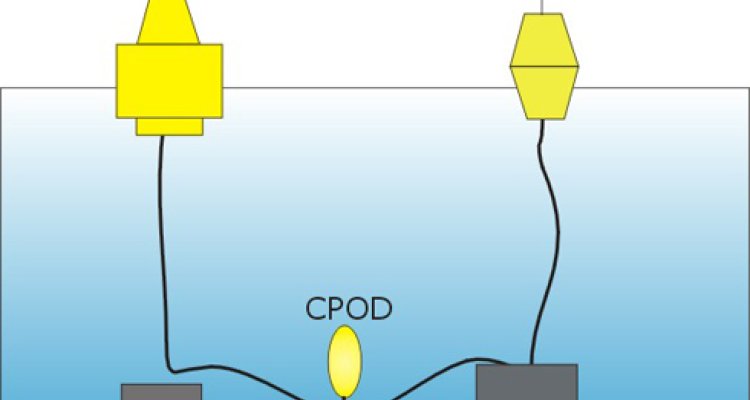
Equipment
Acoustic monitoring of harbour porpoises (C-pods)
The use of C-pods (continuous porpoise detectors) is currently the most common method to monitor the habitat use of harbour porpoises over longer periods.
C-pods are used as standard in effect studies. It is not yet possible to translate the number of echo location clicks into numbers of individuals.
Wageningen Marine Research is an expert in the area of C-pods and has all the necessary hardware and software to collect, analyse, interpret and report data. In the last decade, C-pods have been successfully used in various monitoring programmes for offshore wind parks.

Operation
Porpoises continuously emit clicks used for echolocation to detect prey, orient themselves and -to a lesser degree- communicate. C-pod allows for these sounds to be recorded; they are fully automatic, static, passive monitoring systems that recognise the click trains of porpoises, dolphins and other toothed whales. C-pods can be used in various environments and for a wide variety of purposes.
Although C-pods have limited spatial coverage (radius <300m), they have the great advantage of being able to continously collect data for months. The C-pods are installed in the North Sea in the desired location with a ship from Rijkswaterstaat (the Dutch department of waterways and public works). To prevent collisions with C-pods they are attached to a structure with large marker buoys. The C-pod data are collected on memory cards for about four months and a C-pod can be quickly read out and serviced at sea.
Application
C-pods are used in studies on the effects on porpoises of human activities, such as in offshore wind parks and port construction activities. They are also very useful for policy-supporting studies on the presence of porpoises, as it is possible to monitor porpoise habitat use and behaviour by setting up C-pods in a systematic pattern in a study area. A novel application is detection of so-called 'feeding buzzes' to quantify feeding behaviour.
Publications
- Scheidat M, Tougaard J, Brasseur S, Carstensen J, Van Polanen Petel T, Teilmann J, Reijnders P (2011) Harbour porpoises (Phocoena phocoena) and wind farms: a case study in the Dutch North Sea. Environmental Research Letters 6:1-10
- Weel, S. M. H., Geelhoed, S. C. V., Tulp, I. Y. M. & Scheidat, M., 2018. Feeding behaviour of harbour porpoises (Phocoena phocoena) in the Ems estuary. Lutra 61:137-152.
Reports
- Assessment of the Effects of the Offshore Wind Farm Egmond aan Zee (OWEZ) for Harbour Porpoise (comparison T0 and T1)
- Zeezoogdieren in de Eems: studie naar de effecten van bouwactiviteiten van GSP, RWE en NUON in de Eemshaven in 2010 (herzien)
- Harbour porpoise occurrence in relation to the Prinses Amalia Windpark
- Gemini T-0: passive acoustic monitoring and aerial surveys of harbour porpoises. Geelhoed, S. C. V., Friedrich, E., Joost, M., Juhre, H., Kirkwood, R. J., van Leeuwen, P. W., Machiels, M. A. M., Stoeber, N. & Verdaat, J. P., 2015, Den Burg: IMARES. 110 p. (Report / IMARES Wageningen UR; no. C144/15)
- Gemini T-c: aerial surveys and passive acoustic monitoring of harbour porpoises 2015. Geelhoed, S. C. V., Friedrich, E., Joost, M., Machiels, M. A. M. & Stöber, N., 21 Dec 2018, Den Helder: Wageningen Marine Research. 121 p. (Wageningen Marine Research rapport; no. C020/17)
- Quantifying harbour porpoise foraging behaviour in CPOD data: identification, automatic detection and potential application. Berges, B. P. J., Geelhoed, S. C. V., Scheidat, M. & Tougaard, J., 2019, IJmuiden: Wageningen Marine Research. 41 p. (Wageningen Marine Research report; no. C039/19)
- Feasibility of a Passive Acoustic Monitoring (PAM) network for Harbour Porpoises on the Dutch Continental Shelf. Scheidat, M., Geelhoed, S. C. V. & Noort, C. A., 2019, IJmuiden: Wageningen Marine Research. 41 p. (Wageningen Marine Research report; no. C095/19)